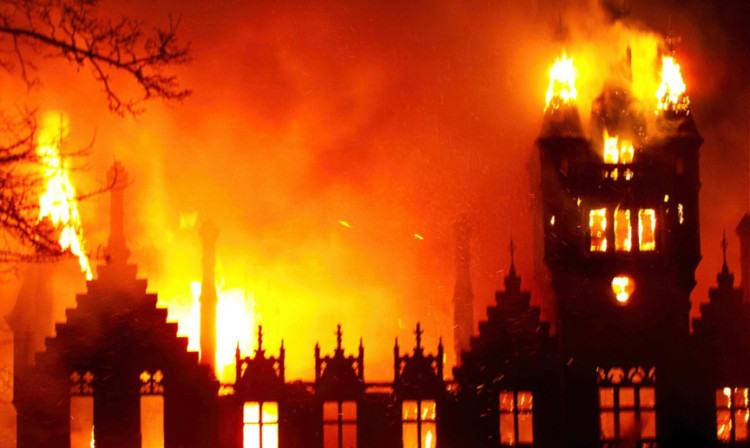The night of drama began with a phone call to fire control from a man walking in Stobswell who looked up to see smoke pouring from the central tower of Morgan Academy.
Within hours the blaze that had taken hold on the roof had reduced one of Dundee’s most beloved and recognisable landmarks to little more than a pile of smouldering rubble.
Now, thanks to Freedom of Information laws, the investigation report drawn up almost 13 years ago by senior fire officers has been released, giving a blow by blow account of their efforts to bring the flames under control and their inquiries into its cause.
It was a blusterly Wednesday evening on March 21 2001 when the smoke was seen rising from the A-listed school, which dated back to 1838.
One of the first to learn of the danger was Morgan’s facilities manager Robert Coates, who was alerted by a phone call while watching a hockey match at Dundee International Sports Centre.
He ran back to the school, activated the fire alarm and helped with the evacuation. The first firefighters arrived at 5.21pm.
It would take them until 11pm to bring the flames under control and by then 80% of the building had been destroyed.
Firefighters had difficulties with the water supply and senior officers had to ask the water board to boost pressure in the area. They brought in 10 pumps and three aerial appliances.
The centre of the fire was located directly above the science lab, which housed various chemicals.
A statement by Alasdair Hay, one of the senior officers at the scene, said: “The turrets and gable ends were structurally unsound, there was a radiation hazard and one wing contained asbestos.
“Each of these problems was recognised and appropriate actions taken to combat them.”
After the blaze was finally put out work could begin on trying to discover its cause.
A report by fire safety officer Steve Mellon said: “The possibility of wilful fireraising cannot be ruled out as access was available to the roof.
“On Tuesday March 20 some schoolchildren had gained access to the roof but had been asked to leave, which they did.
“Due to the fact that no children were seen on the roof on Wednesday March 21, and the time of the fire, this is a very unlikely cause.”
Two other options considered by the investigation were an electrical fire and a defective airhandling unit.
However, investigators decided the most likely cause was work being carried out on the roof earlier in the day by tradesmen.
Mr Mellon said: “Investigation has shown that hot work was carried out on the roof at the north of the building on the day of the fire. This involved torching new felt on to timber.
“Witness reports state that the felt roofers were not happy with the method used. On two occasions during the ‘torching on’ process, parts of the old roof started to smoulder.
“These were immediately extinguished using fire extinguishers. The roof felters finished work for the day at approximately 1610 hours and left the site.
“It is most likely that the cause of the fire was due to the use of naked flames to lay the roofing felt at the junction of the flat roof and the pitched roof.”
Thankfully enough of the school’s iconic facade had survived the flames to allow Morgan Academy to rise from the ashes in a £20 million rebuilding programme that saw pupils and staff return home three years later.
